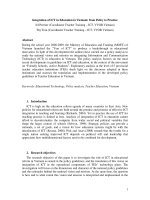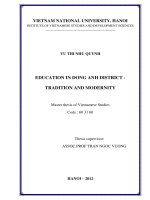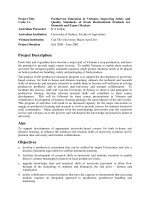Education in Vietnam, a long tradition
Bạn đang xem bản rút gọn của tài liệu. Xem và tải ngay bản đầy đủ của tài liệu tại đây (9.57 MB, 39 trang )
Resource—Lesson 4
Education In Vietnam
A long tradition
Information from Vietnam’s Education—
The Current Position and Future Prospects
Pham Minh Hac, The Gioi Publishers, Hanoi,
1998
Centuries of Chinese
domination—over 1,000 years
Chinese domination—
111 B.C. to 938 A.D.
Chinese rulers opened public schools,
mainly to train their children to
become civil servants for the ruling
class and structure.
Chinese Rule
Children of nobles were sent to
school to study to a certain level
without any examination and then
appointed to the position of
mandarin, a public official in the
Chinese Empire.
Chinese Rule
Statues of
mandarins—
public officials in
the Chinese
Empire
The appointment system was
abolished late in the Chinese
domination and replaced with a
system of examinations for a
doctorate degree.
Outstanding Vietnamese students
were sent to China for examinations.
Throughout Chinese domination, the
education system may be called one of
examinations.
Stelae with names, places of birth and
achievements of men who received
doctorates by examination
Stelae at the Temple of Literature
Chinese Rule
Later, a number of upper class
Vietnamese children were allowed to
attend these Chinese schools.
Confucius—in the Temple of Literature
Hanoi
Independence
After independence in 938 A.D.,
education was carried out at private
and pagoda (temple) schools, but
education was not well-developed.
The country was ruled by the King
from Hue—the capital city
Independence
Children of common people were
admitted to two kinds of schools…
1. Private schools managed by the
people themselves at the village and
communal level, and
Independence
2. under the King’s direct
management in the capital city—Hue,
and a few at the district level and
provincial level.
“ One-pillar” Pagoda
French Rule (1859-1954)
In mid-19th century, the French
colonialists kept the feudal Confucian
education of the previous dynasty.
After 1919, Chinese-like schools and
examinations were abolished.
The French Governor's Home in Hanoi
French Rule
The French developed education
“horizontally” by opening elementary
schools with the first three grades of
primary, not “vertically”.
Schools were modeled after the French
system of education—
Primary schools with only a few grades
were opened in some communes.
Primary schools with six grades were
opened in a number of towns.
French Rule
Junior secondary schools with four
grades were opened in some big
cities.
Senior secondary schools were
opened in Hanoi, Hue and Saigon.
Higher Education began in the 1900s.
In 1908, a number of schools were
merged together to form what was
called “universite”.
In 1919, the first preparatory college
courses were created to teach
physics, chemistry, and biology.
Also, at the beginning of the 20th
century…
The French colonial administration
developed a number of specialized
schools.
Most of them were for training of
workers or medium-level technicians.
French Rule
In 1923, a training course for
medical doctors began.
In 1939-40, Indochinese University
consisted of schools for law and
agronomy (soil management), and
had 582 students.
As a result…
Over 95% of Vietnamese were illiterates,
especially women and ethnic minority people.
The history of the Vietnamese nation was
neglected in the curricula.
The history of the Vietnamese nation was
neglected in the curricula.
Textbooks did not mention Vietnam as a country
—but spoke only of the five countries in French
Indochina.









